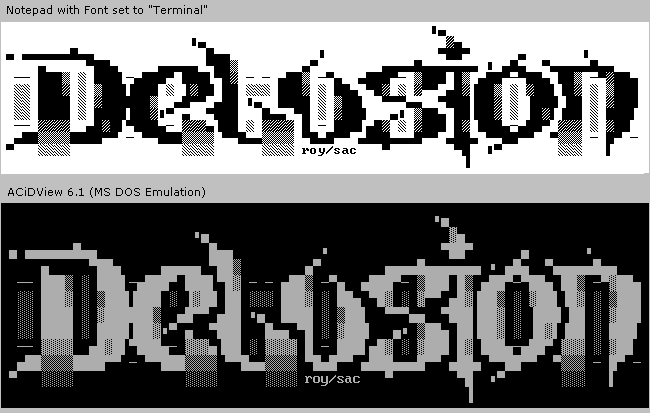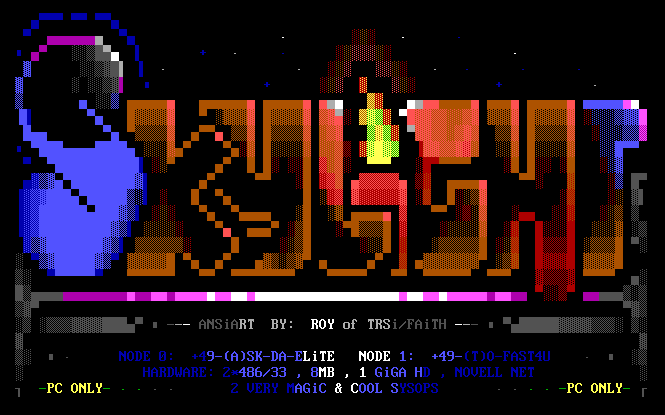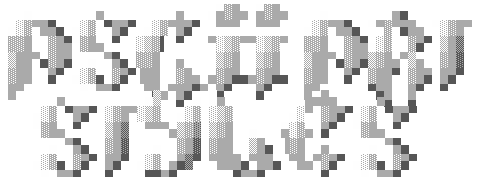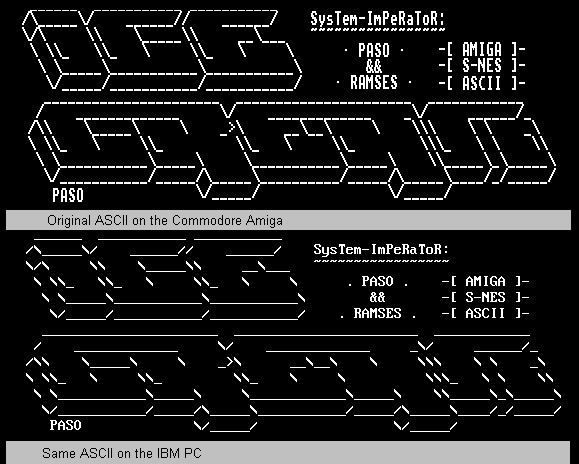Table of Contents

IntroductionThis Article is about the ASCII Art Styles used by the Artists in the Underground Art Scene on the PC and Amiga between 1990 and today. The prime of ASCII and ANSI Text art was during the time when BBS'es (Bulletin Board Systems) were the primary medium for computer enthusiasts and "sceners" to exchange files and communicate. The more important the internet became, the more did BBS'es loose importance. BBS'es and also ASCII and ANSI Text art continues to exist until today, but are considered a novelty by most people and are hard to find. There are 3 distinct Styles, two 7-bit and one 8-bit (high or extended ascii set): The "Oldskool" or "Amiga" style (7-bit), the "Newskool" or "Classic" style (7-Bit) and last but not least the "Block" or "High-Ascii" style (8-bit). Also important to mention is PC ANSI, the colored "cousin" of ASCII; ANSI is not a style, but a format. 7 bit ASCII"Original" is actually another good term for 7 bit ASCII's. Another term would be: "true" ASCII's, because ASCII, standing for "American Standard Code for Information Interchange" is always 7 bit, using only ASCII code 32 (space) to 126 (tilde ~) ).
Here is the US Charsset, starting with ASCII character 32 (space/blank) and ending with the ASCII character126 (tilde: ~). █ ! " # $ % & ' ( ) * + , - . / 0 1 2 3 4 5 6 7 8 9 : ; < = > ?
@ A B C D E F G H I J K L M N O P Q R S T U V W X Y Z [ \ ] ^ _
` a b c d e f g h i j k l m n o p q r s t u v w x y z { | } ~
8 bit ASCIIThe ASCII's using the special graphical characters on a PC (8 bit) are actually not really "ASCII's" in the true meaning of the word, because they are specific to the IBM PC and MS DOS (Code Pages 437 for North America and Code Pages 850 for Europe for example), but nobody really cared for that fine distinction. Those "other ASCII's" are referred to as "Block-ASCII's" so I will leave it at that. You can check out my ASCII art primer, if you want to learn about it in greater detail. As already mentioned, those ASCIIs are unique to the MS DOS IBM PC and can not be found on other systems, including Linux or Unix systems who also run on a PC. Here are a number of graphical characters used by PC ASCII artists. It is not a complete list, but includes the most popular and most frequent used. ░ ▒ ▓ █ ▀ ▄ ▌ ▐ ■ ▪ ┌ ┐ └ ┘ ─ │ ├ ┥ ┴ ┯ ╞ ╟ ╚ ╔ ╩ ╦ ╠ ═ ╬
| ||||
.
______ __:_ . /\_________ _ _:__ _ . __________ .
\__ \ | <_ _______\ | \ | : . /________ \ -============- : -[01/01]-
_ ______| _> \ |______ _/| ___\ \__ __ _/|____|_|_ ____|\___ ___:_____ _ | _\ )__/|______ ____|\ __
|. | _ \ | | | |/ _ \__ \ | |\ _____// _ \ \/ | .| _/--- | /___/ _____ / __ \ \/ \ --\_
. | __|_ |_> >| | |__| \__/__> | : _|__ \| |__ \__/ \ / | | . \--- | . \ < |/ /____\ | .\_/ --/
:_|_/_________/___ |\_____\_____\___/____\_____>____>____\_|\_/| |___|_: - - | |\______|___________/ | --- -
_|. _ \| ___ _ _ ____ ___| |____ ____ _ _ __ \ | _ .|_ - | / .:.nineteeneleven.:.\ | roy
.|_| BLUE SYSTEM _> : <_____________> \ \_ |____\ <_____________> \| <___|. -== |/ ===================== \| ====-
. \ \ | roy/sac |
\ |
\ |
\|
|

Style 2 - "Newskool" or "Classic" Style ASCII Art
The second style which is using characters like "$#Xxo." quite a lot is actually very "classic" ASCII. As a matter of fact, it is as classic as "classic music". The Scene referred to the style wrongly as "Newskool", because the sceners, who were just "teenagers" for the most part, did not know better. "Classic" ASCII art (using the term "Text art" for classic ASCII would be more appropriate) was not known to most "sceners". They were simply too young to know.
"Oldskool" and "Block" dominated the Scene when BBS's became popular. They evolved at the beginning separately, "Block" on the PC and "Oldskool" on the Commodore Amiga. The "amiga" style made it's way to the PC years after its creation.
The "classic style" made its comeback much later and was completely new to most sceners, thus coined "Newskoool".
Well why should it be different than in the Music or Movie industry. Trends go in cycles. Something gets old, forgotten and the much later revived and re-introduced as the "New" Trend.
On the classic MS DOS was the background dark (black or blue) and the font white or light gray for good contrast. You do probably understand now the choice of colors for this Site. It changed to Light background color with dark font with the introduction of Microsoft Windows (3.x), unless you had a Commodore Amiga of course.
Here is a Newskool ASCII to give you an Idea how newskool ASCII's look like. This is also not an image, but real text like the Oldskool ASCII's above.
.
.o$$$$$o. o. .o$$
.'.$$$ `$$$$ $$ W e l c o m e t o . . . $$$$
.: $$$$ $$P'.$$ $$$$
`: $$$$ . $$$$ . .o$$$$$o. o$$$o. .o$$$$o. .o$$$$$$$o. .
` $$$$ $$o.`$$ $$o.`$' $$$$ `$o. $$$$' $$$$ $$' $$$$ .
.o$$`$$$ .$$$$ $$ $$$$ $ .$$$$ . `$$o.`$$ """' $$$. $$P' :: .
$$$$ `4$$$$$P'`$$$$$$P'`$$$$$P' 4$$$$P' 4$$$$$o. `4$$$$$$$o. .::`
$$$$ oooo ..::.......::......::......:. $o. ...::........ ..:::.
$$$$ $$P' `:::::::::::::. .o$$o. .::::' $$o. :::::::::' .o$ ::::.
$$$$ ` .:'" `::'" "" .:' " $$$$ `::::' " .o$$ `' `"
`4$$$$$o. .o$$$$$$o..o$$$$$$$ $$o..o$$$$o.`$$$$o. '.o$ $$$$.oOOOOOOOOo.
.`$$$$ $$$' $$$$ $$' $$P'o$ .o$$' $$$$ $$ o$$$ $$$$ . $$ $$ .
.o$ $$$$ $$$ $$$$ $$ $$$ $$$$.o$$P'.$$ $o.`$$$ $$$$ : $$ $$
$$$$ $$$$ $$$. $$$$ $$. $$o.`$ `$$$. $o. o$$. $$o.`$$. $$$$ ' $$ $$
`4$$$$$$P' 4$$$$$$P'`$$$$$$$$ $o.`4$$$$$$o.`$$$$$$$ 4$$$$$$$$o.`$ $$
<=============================================- o $$$$ o$ $$
<====- SAC - Superior Art Creations INet WHQ -=- .o$ $$$$.oOOOOOOOOo.
<====- LKCC - Last KC Computerclub INet WHQ - .o$$ $$$$ -=========>
<===========================================- $$$$ $$$$ -= roy =>
`4$$$$$$P'
|
ASCII Art Display in Windows
It is usually not very hard to display 7 bit ASCII's on any Platform, Windows, Mac, Linux etc..
All support non-proportional or fixed-width/fixed-pitch or monospace typeface fonts (uses fixed glyph widths) such as Courier, FixedSys, Monaco, , Lucinda Console or Terminal and the ANSI Standard X3.4 from 1968.
This is unfortunately not the case with MS DOS 8 bit "Block" or extended ASCII's where the extended MS DOS Character Set is used.
Style 3 - "Block" or "High ASCII" Style ASCII Art
So called "block ASCII" or "high ASCII" uses the extended characters of the 8-bit code page 437, which is a proprietary standard that was introduced by IBM in 1979 (ANSI Standard x3.16) for the IBM PC and MS DOS operating system in an effort to standardize graphic character representations and cursor control.
"Block ASCIIs" were widely used on the PC during the 1990s until the Internet replaced BBSes as the main communication platform for computer enthusiasts around the world. "Block ASCIIs" were dominating the PC Text Art Scene.
The 8-bit Character Set was a "PC Standard" and supported from the first, until the last MS DOS Version but is today rarely supported by any software anymore, in a world dominated by MS Windows. Microsoft elimited the support of ANSI Standard x3.16 almost entirely in MS Windows for unknown reasons.
It was never supported by any other Computer Hardware or Operating System. Apple (Macintosh), Commodore (AMIGA), SCO (Unix) nor Linux ever suppported "Block ASCII" or ANSI Standard x3.16. It became a "pseudo standard" that was destined to die.
Since almost all BBS Systems running on a IBM or compatible PC between the end of the 80'th until the end of the 90'th were written for MS DOS, ANSI Standard x3.16 or Block ASCII was used by most Sysops for their BBS designs.
Also most PC Warez groups used Block ASCII for their .NFO File designs. They continue to do so until this day. The heyday of "Block ASCII" might be a thing of the past, but it is not dead nor forgotten yet.
"Block" ASCII display in Windows
There are 3 general options available to view Block ASCII's properly in Windows.
Option 1
You have to open a DOS Window and use the classic "type" command or a classic MS DOS Text Viewer/Editor to display the ASCII properly.
Option 2
You can also use Windows Notepad as alternative. You must set the Font used by Notepad to "Terminal". The result is not the same as in a MS DOS Window.
It is more looking like a inverted version of it. You can design ASCII's that look great in a DOS Window and ugly in Notepad and vice versa or one that looks good in both. You can see what I mean in the following example (screenshot image).

Option 3
Use a Windows Tool that emulates Block ASCII. The best Tool I know of is ACiD View for Windows.
PC "ANSI" Art
The "colored" cousin of ASCII, ANSI is pretty much not supported by Windows anymore. You can use the 220KB Windows Tool ACiDView to view them (download here) or open a DOS Window with ANSI.SYS Driver loaded (which is not the case by default) and use the "type" command again or you simply open it with a DOS ANSI Editor like TheDraw (download here).
TheDraw will be quite a challenge for somebody who grew up with Windows and Mouse and is not familiar with the use and handling of old fashioned MS DOS Applications. TheDraw is still useful today, not just to create ANSI's and ASCII's, but also to easily convert files from ANSI to ASCII format (I don't know any Windows Tool that does that).
ANSI Colors were very limited but better than "Black and White" ASCII's. 16 static colors that could not be changed were available as Foreground Color.
The first 8 could also be used as Background Color. Although the 16 Foreground Colors were also available as "Blinking" color (making it a total of 32 Foreground Colors), did artists avoid those blinking colors after a short time of popularity.
It's funny, but exactly the same happened on the Internet. Blinking HTML Code was hip until people got tired and annoyed by it until it pretty much disappeared completely.

Here is an ANSI which I created for a friend of mine and fellow Sysop in 1994. The Name of the BBS was Skylight BBS. It is one of my first ANSI's which was taken very serious and defined my own style "Roy-Style". I wrote a bit more about this particular ANSI in my Blog. About Skylight BBS Ansi Logo (1994) and Deviance NFO File Ascii Logo (2002).

Further Reading and Related Resources
If you are interested in learning more about the history of classic ASCII Art, check the Text (ASCII) Art History Article written by Joan G. Stark in 2000, my ASCII Art Academy content and also the other quality sites that can be found at my Art/Demoscene Links Section.
Also, to learn more about ANSI and ASCII Text Art, BBS'es, Demoscene, Warez Scene, the beginning of the computer age etc., check out my Links Section and also my Merchandizing Page where you can find related DVDs, DVD-ROMs and Books about the topic.
Back to ASCII Art Academy
Videos, Tutorials and ASCII Art by Various Artists
- Online Videos releated to text art, BBS, demoscene, SAC and Warez
- ASCII Art Academy - Tutorials, History and more to ASCII Art
- ASCII/ANSI Art Galleries with artwork by me and various other ASCII/ANSI artists
- ASCII Nudes Collection - 30 Years of "Naked" ASCII Art - 30 pieces of ASCII art showing nude girls created by hand by various different artists. A "boss key" feature is available too, which is interesting by itself, showing additional examples of great ASCII art without nudity.
- "Morph" - ASCII Animation (ASCIIMation) using JavaScript created by Skylined. It "morphs" a number of ASCII pictures from one into another and finishes with a great "mandelbrot" fractal zoom.
- "Star Field" - Another nice ASCII Animation using JavaScript created by Skylined showing a horizontal semi 3d star field animation like the ones that were popular in old computer demos and intros.

 The first style of ASCII is using primarily slashes and lines (/\-|_) and came originally from the Commodore Amiga. It is referred to as "oldskool". You will be surprised to hear that there was a very unique reason why this style was so dominant on the Amiga Computers.
The first style of ASCII is using primarily slashes and lines (/\-|_) and came originally from the Commodore Amiga. It is referred to as "oldskool". You will be surprised to hear that there was a very unique reason why this style was so dominant on the Amiga Computers. 

